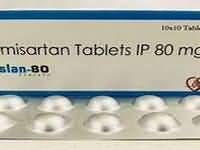CLINICAL USE
Angiotensin-II antagonist:Hypertension
DOSE IN NORMAL RENAL FUNCTION
20–80 mg daily
PHARMACOKINETICS
DOSE IN RENAL IMPAIRMENT
GFR (mL/MIN)
DOSE IN PATIENTS UNDERGOING RENAL REPLACEMENT THERAPIES
IMPORTANT DRUG INTERACTIONS
Potentially hazardous interactions with other drugs
ADMINISTRATION
Reconstition
–
Route
Oral
Rate of Administration
–
Comments
–
OTHER INFORMATION
Hyperkalaemia and other side effects are more common in patients with impaired renal functionClose monitoring of renal function required during therapy in patients with renal insufficiencyRenal failure has been reported in association with angiotensin-II inhibitors in patients with renal artery stenosis, post renal transplant, and those with congestive heart failure.
